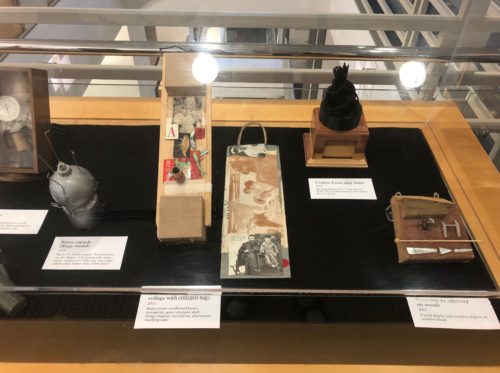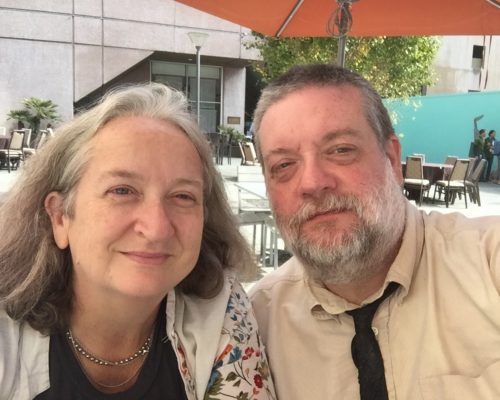Collage artists use found objects to capture neighborhood identity and history

OUR COLUMNS
On the fourth floor of the downtown San Francisco Public Library, a collage exhibit teased my mind _ and my fancy. More so, when I realized I knew one of the artists. David Cox and Molly Hankwitz, of the Bivoulab Studio collective, have glued, pasted and duct-taped everyday objects in ways that are oddly provocative – for example, a miniature space capsule made out of a Christmas tree ornament, an aluminum soda can, safety pins, paper clips, and silver paint.
A wooden airplane their 16 year-old son, Simon, made years ago at a summer camp at the Randall Museum, sits plaintively among more warlike objects.
The title of the exhibit, “Collapsing of the Axes,”refers to the state of the world today, where the adhesives of nation, religion, other certainties that used to bind us together are collapsing and being replaced by loyalty to streets and brands.
Cox describes his method as “the drift. I follow my feet. I wander through the city without a particular purpose, looking for ways of using the city that are not commercial. It’s amazing what can be found on the street. The more resourceful people have become, the more likely we are to find odd things. Things fall off buildings, cars, people.”

He pointed to a battered, corroded case containing a pair of glasses.“I found them in the street in front of a Mexican restaurant. I couldn’t believe I was the first person to pick them up. It’s a most amazing thing, someone had just dropped them and they got run over again and again and again.”
Cox is a filmmaker, artist, writer, and instructor in the design department at San Francisco State University, where he teaches courses on digital media. He also teaches in the game development and visual media departments at City College of San Francisco.
Hankwitz is a lecturer on the history of photography and modern media art at San Jose State University. She also teaches computer classes for the San Francisco Community Living Campaign.
A statement against gentrification
For “Collapsing of the Axes,” they limited themselves to objects found on several blocks of streets around their home plus objects tucked away in their kitchen cabinets. “We work around the kitchen table,” Hankwitz said. “We lay out the objects and turn on some music, and just start putting them together. Sometimes, Simon joins us.”
She sees the work as a way of hanging on to pieces of her Mission District neighborhood, which is rapidly gentrifying.

“This art is a way to resist the impact of gentrification. It’s grounding ourselves in our home and our neighborhood. It’s a map of time in the Mission, a way of helping us uncover more of our neighborhood for ourselves,” Hankwitz said.” I like the sensibility of doing art like that,”
The collage aesthetic is strong in the Bay Area, Cox said, “We’re an eclectic part of the world. There’s a tendency of collage to emerge during economic uncertainty; it’s a material response to fragmentation in a time of uncertainty.”
The purpose of his art, he said, is to show that “dignity can emerge from humble objects.” And it’s something everyone can do, added Hankwitz. “Collage is accessible, it’s making free associations.”
She would like to see others doing this kind of work as a way to remember and celebrate their neighborhoods.
The exhibit runs through Nov. 29. A closing event, “Object-oriented oddities from the Zone,” will be held from 3 to 4:30 p.m. in the Library Sycip Room on the fourth floor. Their work can often be found at the ATA Gallery on Valencia Street. Parts of the library exhibit were initially displayed at their neighborhood Atlas Café.





